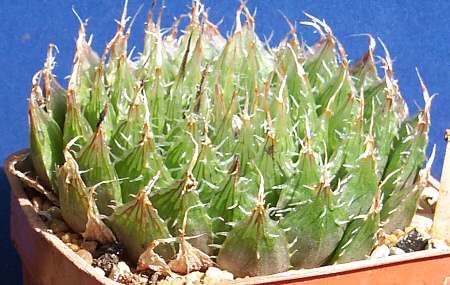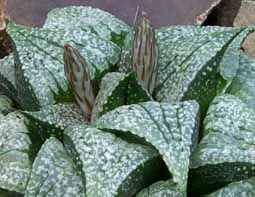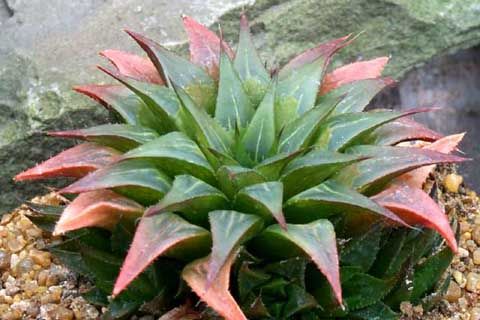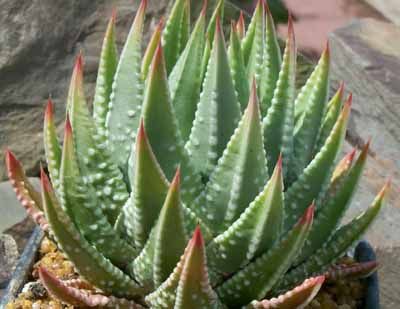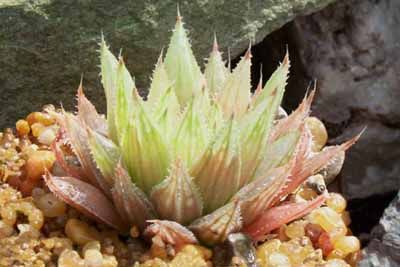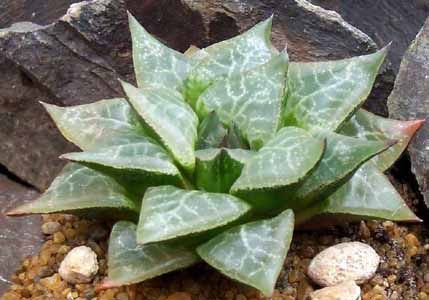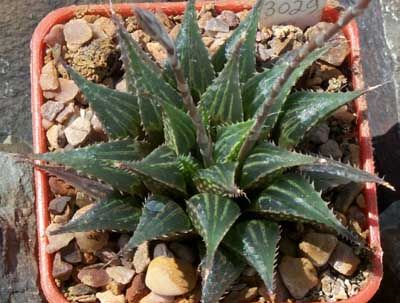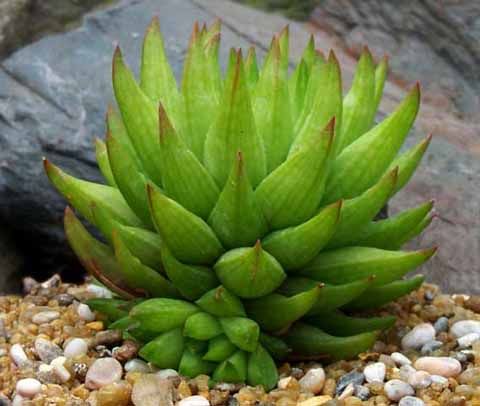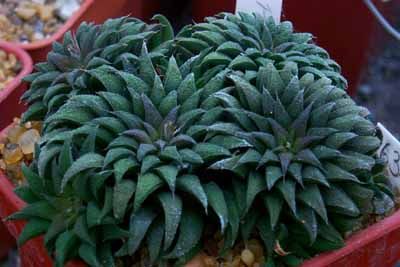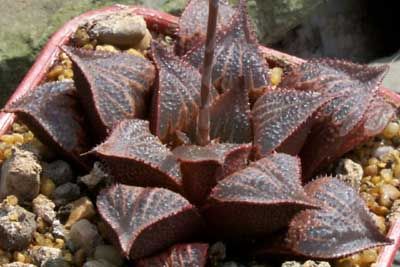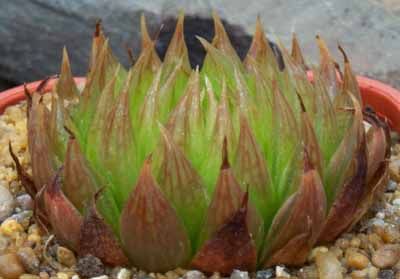Haworthia
|
|
|
|
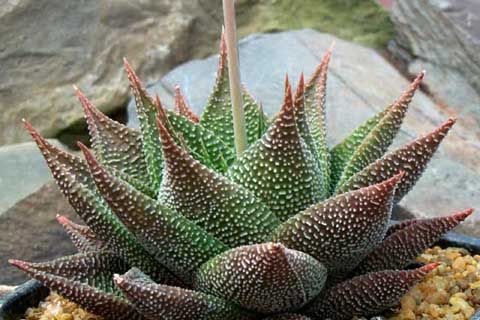 |
|
H. decipiens |
H. emelyae v. picta |
H. heidelbergensis |
H. limifolia v. gigantea |
Family: Asphodelaceae
Origin: South Africa, Madagascar
Height: under 6 in. (15 cm)
Width: 3-6 in. (7-15 cm)
Sun Exposure: Light Shade
Watering: regularly; do not overwater
Description:
Haworthias are small succulents that have been fascinating collectors since the 17 century when they where still regarded as aloes, bu they are only related to Aloes and Gasterias. This Genus comprises perhaps 70 to 90 species
Haworthias are grown for their shape and markings. They are characterized by a small 2-lipped white flowers. They are all rosette shaped succulents, although some have rather grassy leaves. Some can add leaves until they are somewhat columnar, while other remain as flat rosettes.
The fleshy leaves may be pointed or blunt, truncated or almost oval. Most are green but some are dark or may be almost transparent and may be covered with attractive markings or tuberculate. They are not frost hardy, which means that for cultivation they need either a sunny windowsill or preferably a greenhouse. The leaf shapes and markings are highly variable but a common feature in most haworthias is the presence of whites spots on the leaves.
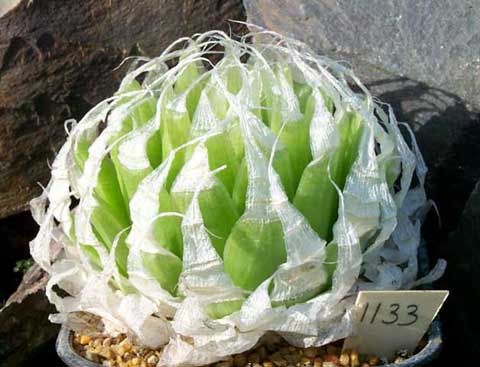 |
|
|
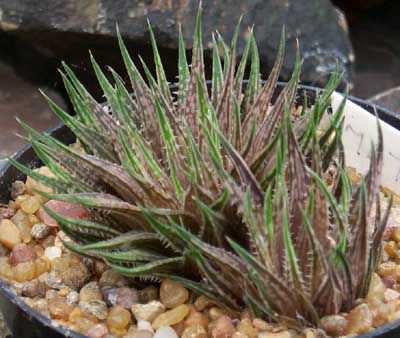 |
|
H. lockwoodii |
H. marginata |
H. outeniquensis |
H. monticola |
Cultivation and care:
Haworthias will grow under many different conditions, but they grow best if given lots of light, with water only at the appropriate time One overall formula as to when to water, how to water, what soil to use, and when to fertilize, will not work because where you grow your Haworthias will determine how you approach these issues. For example, Haworthias grown on a windowsill in Bucharest will require a different treatment compared to those grown in Moscow or in a greenhouse in Tucson. All is not lost however, because as you dig deeper and look at what the plant's needs and then take into consideration your local conditions, you will grow beautiful Haworthias.
Haworthias like shady areas with moderate water and regular feedings, the plants tend to go orange-red in hot weather when they are dormant but they regain their green colour when the weather cools and they resume growing. In shade the body color will remain mostly green, while full sun will darken it and give it red/brown body color. Can be sunburned if moved from shade/greenhouse into full sun too quickly.
Lets start with choosing the pot. Use a terra-cotta clay pot if you live in a colder wet climate and a plastic pot if your area is hot and dry. The unfired terra-cotta clay will breath and allow moisture to escape more easily in a wet climate, while the plastic will preserve the moisture for the plants roots in a dry climate. The idea is to create an environment for your Haworthia that will allow the plant to dry out after it has been watered, as remaining wet for too long will cause root rot during periods of dormancy. Pot size is important here also. If your world is cool and wet, an undersized pot will dry more quickly than a larger size, and that is good. However, if you grow in a hot dry climate, it may make more sense to pot in larger pots that dry more slowly.
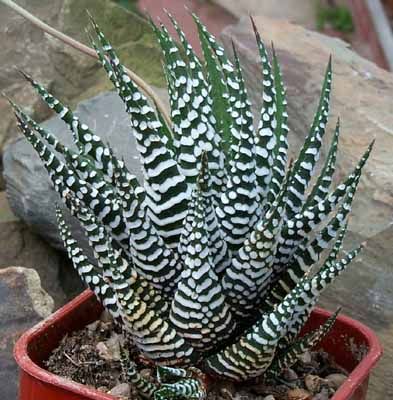 |
|
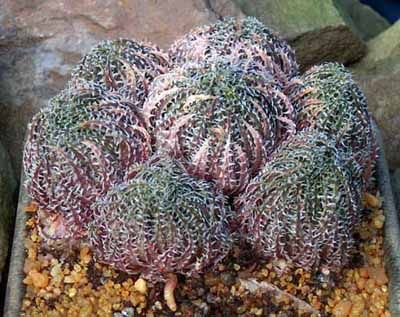 |
|
|
H. attenuata v. caespitosa |
H. emelyae v. comptoniana |
H. herbacea v. luteo-rosea |
There are several rules that should be followed regarding soil selection. The soil should be free draining, meaning that it is porous. This can be accomplished by making a potting soil using as a component materials such as; perlite, pea sized pumice, or even pea gravel and some organic mater, but not so much that it becomes water logged and rots your plants roots. Use 1/3 pumice (pea sized) 1/3 perlite, and 1/3 potting soil, which consists mostly of leaf litter. Be careful not to water when you expect an extended cold or cloudy period. The soil, and its moisture holding capacity, must be considered when watering. A lot of water on a hot summer day with many more hot days in the forecast is probably necessary, while even a little watering during a very cold damp time, might be too much.
Planting. Hold the Haworthia with one hand and place soil into the pot around the Haworthia. Place the soil loosely around the roots and then pack it down by striking on the side and by gently packing around the plant until the soil is firm and the Haworthia is comfortably potted. I try to leave a 1/2" to 1/4" of pot rim so water will not overflow too easily. You use a top dressing layer of stones or gravel. Its advantages are the obvious esthetic one, but a good layer of rock will, if properly applied, form a barrier that discourages fungus gnats from laying their eggs in the wet soil. The disadvantage of a top dressing is that it becomes more difficult to determine how wet the soil is if it is protected by a layer of rock. Getting to know the weight of a wet pot and a dry pot is a good trick that will help get around this problem.
Light. For growing, a greenhouse is ideal, next choose a sunny South facing window. If a South facing window has a tremendous amount of sunlight, slow acclimate your new plants by placing several layers of a thin lacy cloth between the plant and the sun. Then slowly remove a layer at a time at three week intervals to allow the plant to adjust to the hot sun. Never place it in the direct bright outdoor sunlight, for even a few minutes could burn the plant so it is disfigured for years. If you move to the outside in the summer be under the shade of a tree. If you must put your plant directly in the sun, do it very gradually.
|
|
|
|
|
H. mirabilis v. sublineata |
H. pulchella v. globifera |
H. parksiana |
Watering your Haworthia is actually much easier than you might think. Here is the rule - water when dry, do not water until the soil is approaching dryness. When you water your Haworthia, go ahead and water it until water flows out the pots bottom hole. Then do not water again until the soil is dry. After awhile you can tell by the pots weight, but the best way to tell if watering is needed is to dig your finger or a pencil into the soil down to an inch or more and see if the soil is damp. This method works very well because if you water your Haworthia and then a wet cloudy weather system sets in, it might not require watering for 4 to 6 weeks. However, in the summer, with lots of sunshine, a twice weekly watering might be required. The only caveat here is to be careful during cold wet winters, as a dead plant from rot can occur in days.
For optimum growth, fertilization is a good idea. However, the rule is to fertilized only with a dilute fertilizer, and only when the Haworthias are in active growth, such as the spring and in the fall. Applying too much fertilizer will encourage too much foliage growth, producing grotesque plants. In the extreme, too much fertilizer will kill your Haworthias. Go easy on the fertilizer, and when in doubt don't fertilize. If you repot every few years (highly recommended) it is actually not necessary to fertilize! Your plants will grow more slowly, but no harm will be done.
Propagation Methods:
1. Offsets that appear at the base.
2. Leaf cuttings.
3. Seed.
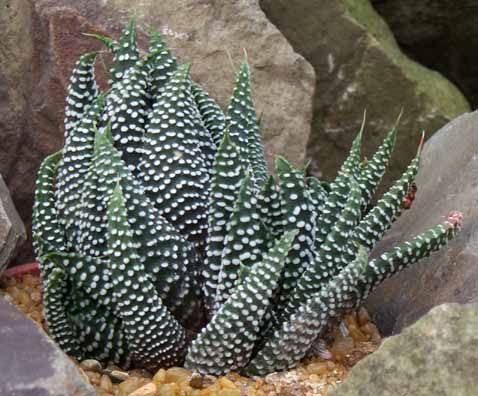 |
|
|
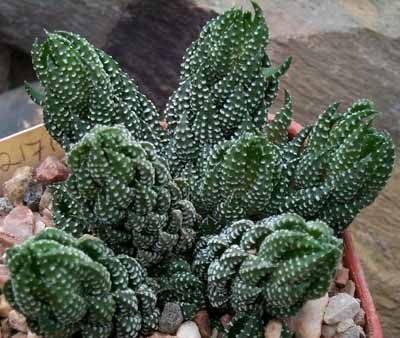 |
|
H. minima v. poellnitziana |
H. mirabilis v. beukmannii |
H. mucronata v. morrisiae |
H. reinwardtii v. bellula |
Articole asemănătoare
-
Cactusi si plante suculente. Haworthia.
Familie: Asphodelaceae Origine: Africa de Sud, Madagascar Haworthia este un gen de planta suculenta care i-a fascinat pe colectionari inca de la inceputul secolului al 17-lea, cand era privita ca fiind aloe - de fapt ea este doar inrudita cu aloe si gasterias.
